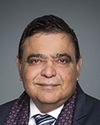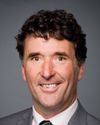Thank you, Madam.
We'll go to Mr. Obhrai.
Mr. Obhrai, you have seven minutes.
Evidence of meeting #23 for Foreign Affairs and International Development in the 39th Parliament, 2nd Session. (The original version is on Parliament’s site, as are the minutes.) The winning word was darfur.
A recording is available from Parliament.
3:55 p.m.
Conservative

The Chair Conservative Kevin Sorenson
Thank you, Madam.
We'll go to Mr. Obhrai.
Mr. Obhrai, you have seven minutes.
3:55 p.m.
Conservative

Deepak Obhrai Conservative Calgary East, AB
Thank you, General, for coming. As usual, it's a pleasure to listen to you. I'll be sharing my time with my colleague.
General, I have two quick questions. When Mr. Manley came in front of the panel he stated that you had made a request for 1,000 additional troops. When the question was asked whether 1,000 troops were sufficient to meet the security requirements of the region, he said that was something you had recommended.
Perhaps you'd like to advise us as to whether this additional 1,000 would meet the total requirement. Why would you stick to just 1,000, and not more?
Regarding my second question, the day before yesterday, 17 workers who were building roads were killed by the Taliban, which clearly indicates the need for security. It's very important if development is going to take place. Without that security umbrella, the development aspect of it would become quite difficult, as this killing of 17 workers has indicated. That leads to the question of how quickly this security umbrella can be passed on to the Afghan army and the Afghan police themselves, with our forces taking an advisory role.
Perhaps you can give us a picture on those points.
Mr. Lebel, if you have a question, you can ask it now.
4 p.m.
Conservative

Denis Lebel Conservative Roberval—Lac-Saint-Jean, QC
Good afternoon, General Hillier.
Earlier, you called on us to be proud of our troops, and we are heeding that call. I phoned several young soldiers in my riding when they came back to Valcartier after a tour of duty in Kandahar. We are proud of what you and your troops are doing in Afghanistan.
My question follows on from Mr. Obhrai's. What are the chances of success of our mandate to train the Afghan police and army? Are we going to keep concentrating on that in the next months? Are the Afghans receptive to the training we are giving them?
4 p.m.
Conservative

The Chair Conservative Kevin Sorenson
Thank you, Mr. Lebel and Mr. Obhrai.
Go ahead, General Hillier.
4 p.m.
Gen R.J. Hillier
Mr. Chair, thank you for the questions.
Let me just say that I did tell Mr. Manley and his panel that we needed another manoeuvre battalion group in the south, specifically in Kandahar province. The first thing that led me to say that was that NATO had done the assessment almost two years ago and had said the structure in Kandahar province should include two battalion groups, and we had one. My point was to have us help NATO coalesce its efforts to fill its own structure, which it had laid out two years previously but had not been able to do.
We're doing some very good things now and making some very good progress. If we get more troops, we can make more progress more quickly and possibly at less risk to our soldiers and other security folks, including Afghan folks involved in that mission. The more troops you get in Kandahar province in the shorter term, the better you can actually improve things and the better space you can get to allow development like roads and electricity to take place. Then you can start winning the population over irreversibly to a non-violent approach, to a democratically elected government approach for their country for the future.
So the 1,000 troops, based on the assessment NATO had done and also based on our assessments, would give us a much greater capability and allow more progress to take place quickly.
Actually, it's a growing realization that the more troops you have, even beyond that, the better you can do. That's one of the reasons we're trying to build an Afghan National Army brigade with the Afghans in the south. As I mentioned, too, 18 months ago there were no Afghan soldiers there. We went through Medusa and we had none with us, despite our desire to start building that capacity.
Now we have the three battalions. We have what we call a combat support battalion, which is artillery, engineers, and those kinds of things. We also have a combat service support battalion, which is the beans, the bullets, and the medical assistance. And then we have headquarters over that. Those battalions are not all at the strength they're going to be yet. They don't all have the equipment they need yet. And they have a variety of training issues and leadership challenges, because they're still very new in their development. We know in the Canadian Forces just how long it takes to rebuild a brigade or a battalion after you've emasculated it over a period of time or to change it if you already have it in place. It's a long-term process developing leaders at the level of Brigadier-General David Fraser, for example. That's a 20-year product. There are leaders like that there. How can we enable them over the shorter term?
Let me just tell you this. We had a training team over the last two years in Kabul that worked at the Kabul manoeuvre training centre. They took every single battalion coming through during that timeframe and ran them through a three-week final exercise. They trained some 30,000-plus soldiers with Canadian NCOs and Canadian officers. That was their sort of graduation exercise. Those soldiers went out in the battalions, and over the last 18 months, that brigade showed up in Kandahar.
We now have an OMLT team of about 25 to 27, depending on the battalion, with those battalions. We've helped equip them with the C7 rifle, which is certainly a significant step up from where they are right now. We've helped them build an operational, training, and recuperation cycle, because those same soldiers have now been in the fight for 18 months. You understand that they need a break from intense operations. Many of their families are located all around Afghanistan. If you keep them away continuously, you'll destroy them. Also, when they get the first opportunity, they'll leave and vote with their feet and go back to their families. We've helped them get pretty close to a sustainable cycle, thereby reducing attrition and increasing their capability to the point that when we did operations in the Arghandab, just before Christmas, that battalion, which we had move into that area, did most of the planning for it--yes, with our assistance--and did most of the lead in the operations.
The second part that's given us some great measure of what they are capable of doing is that in Zhari district we have withdrawn our significant combat team that was there and moved it to Arghandab. We have left Zhari district security, by and large, to the Afghan National Army battalion and to the Afghan National Police. They've reached a decent level of training. Yes, they are supported by us in a variety of ways. Yes, we're ready to go back in if they meet something that's beyond their capacity, but we've brought them to that level.
The third part, which we're now moving to, and this is from NATO and from SACEUR, Supreme Allied Command Europe, where they want to focus in the future, is not just the OMLT team with the Afghan battalions; it's partnering our units, our rifle companies, for example, with their battalions and operating together. We provide a bit of a core for them to do things and stretch past what they're doing normally, so that they have confidence that they can actually go out and do something and that they have the right stuff with them.
We're moving towards that now. That's part of what the marine unit will do when it comes in.
We've made good progress. We have a long way to go. It takes a long time to build an army. We're building a brigade of that army. We don't control all the pieces that come into it. If the Afghans can't recruit and the Americans move a battalion out, all things change. But with what we're doing, we're making great progress in building our army.
Truthfully, I've seen an amazing move forward over the past six months. When they'll be able to take over complete security for themselves is something I can't say. We have just moved one of their battalions up a level of validation because of the progress they've made, and we keep working that one hard.
4:05 p.m.
Conservative
April 10th, 2008 / 4:05 p.m.
NDP

Paul Dewar NDP Ottawa Centre, ON
Thank you, Chair.
And thank you, General, for being the opening act for the committee--and the closing act, because I think you'll be our last witness before we do our report. Thank you for coming today.
I want to start with the Manley report and the motion that went through the House. It obviously was about the 1,000 troops, but also about the helicopters and drones. Can you tell the committee what the approximate costs of the helicopters will be? We've heard different figures thrown around, so I wonder if you could help us with your knowledge of this.
4:05 p.m.
Gen R.J. Hillier
Sir, first of all, no, I cannot. That's not because I'm trying to avoid the question or sidestep it or anything. It's simply this. We're in a real short-term process to see how quickly we can meet what the Manley panel said. Much of this, that we needed helicopters, that we needed UAVs, came from me; it was also reinforced by others. We're in a short-term process to see if we can lease helicopters in the next several months. So contract negotiations and those kinds of things are ready to start. You cannot define the cost of that until you're actually in those contract negotiations.
Secondly, we want to see if we can offer the government an option to buy some CH-47s that are already operationally equipped for the mission in Afghanistan from the U.S. Army. They're slightly older helicopters, but they're operationally fit. We don't know what they will cost at this point in time. We have to walk through that first part, define the cost, and say, here's what we can get for this amount of money, or here's the value we can get that we think is operational, and here's what it will cost.
4:05 p.m.
NDP

Paul Dewar NDP Ottawa Centre, ON
The government put a ballpark of $4.7 billion on the 16 CH-47 Chinooks. We're hearing that the costs of the Chinooks are between $15 million and $20 million. Does that sound about right to you?
4:05 p.m.
Gen R.J. Hillier
You're talking about the cost to buy the 16 Chinooks?
4:05 p.m.
Gen R.J. Hillier
I personally think the--
4:05 p.m.
NDP

Paul Dewar NDP Ottawa Centre, ON
I guess what I'm saying is, do you have a ballpark figure? I think one of the concerns that people quite rightly have is that if we're going to have the extension of the mission to 2011 and it's going to come with the demands we've been asked for--the 1,000 troops, the helicopters--it's a fair question to get an approximation.
I understand what you're saying. It depends on whether you're going to lease or buy; there's a difference in what you're going to get. But is there an approximation of what it will cost? I guess you're saying that we don't have that approximation to date.
4:05 p.m.
Gen R.J. Hillier
If I could try to help focus it, first of all, we're not operating on “if” we're going to have an extension to 2011; we're planning on getting on with it, sir.
4:10 p.m.
Gen R.J. Hillier
Second, the 16 helicopters we're buying for the longer-term operational capability of the Canadian Forces for Canada are not going to be delivered in time to meet the demand that the Manley panel.... So we're looking at something different, but hopefully connected, and I don't have the numbers to give to you for that.
4:10 p.m.
NDP

Paul Dewar NDP Ottawa Centre, ON
I would like to turn to some of the questions that Mr. Rae had. I asked Mr. Manley when he was in front of the committee, before the motion passed, a question around how the command and control will work with the American troops. I had predicted at the time that we would have the American troops as a complement to the 1,000. I think that was fairly well-known. We now have the French moving to the east, so the Americans are freed up to the south.
My concern, General, is that when you look at the marines and the way they operate in the field, many would suggest it's very different from the way we operate in the field. They use air more than we and others do. Notwithstanding your explanation to Mr. Rae about how that works through the regional command, my concern is the effects it will have on our command and control. If they are indeed reliant on more use of air strikes than we are, what will the outcomes be vis-à-vis civilian deaths? We've seen civilian deaths go up in the last year. It has not been intentional, let me be clear, but that's been the outcome.
General, many of us want to know your best guess as to the effects on our troops with the Americans in the field. They'll be under ISAF and OEF, but it's my understanding--correct me if I'm wrong--that the ones under ISAF usually dance to their own drummer, and they usually don't take command from other countries, generals or anyone else in the field.
4:10 p.m.
Gen R.J. Hillier
Thank you for the question.
Let me just say, you can say “dance to your own drummer” for every single one of the countries that are involved in the NATO mission from time to time, depending on how you look at it.
I actually have a great deal of comfort. Let me just tell you that they are going to work for the NATO commander as part of the NATO mission, and with that there are NATO rules of engagement and there is a standard that has been established.
I can tell you for sure that despite the violence caused by the Taliban in heavily populated areas, there is a laser-like focus by the NATO chain of command at every single level, right down to our most junior soldier of any nationality, to ensure that collateral damage is prevented, if at all possible, and minimized.
That includes the marines, because they understand that success for their mission is not going in and having significant collateral damage and having the people of that area turn against them and therefore support the Taliban more. They're going to operate under the same rules of engagement. They're an incredibly professional organization. We've had the opportunity to establish liaison with them. They'll work to the NATO rules of engagement. They're professional soldiers. We know that from our perspective. And I don't necessarily believe they will use, for example, more air strikes, unless those air strikes are warranted, but they will certainly not use them in any conditions that would be unwarranted, than any other troops on the ground would.
I have a confidence that comes from an association with some of the United States armed forces before, but also from the command and control structure we have in place in Afghanistan, which is NATO.
There is a focus, I'll tell you, because we know what the winning conditions must be. That has not been a part...having immense collateral damage and therefore turning the population away from us. There is a huge focus on it to make sure all of the methodology is there.
4:10 p.m.
Gen R.J. Hillier
Sir, I'll tell you, it won't be perfect. That's the only thing I will say. You know that, and we know that too.
4:10 p.m.
NDP

Paul Dewar NDP Ottawa Centre, ON
I appreciate that. I just wanted to know the context, the difference between the Americans and us. I think you've shed some light on that.
4:10 p.m.
Gen R.J. Hillier
Thank you, sir.
They don't speak with a Newfoundland accent. That's the only thing I'd say about those folks coming in.
4:10 p.m.
Conservative

The Chair Conservative Kevin Sorenson
That's right.
Mr. Goldring, you have five minutes. This is the second round.
4:10 p.m.
Conservative

Peter Goldring Conservative Edmonton East, AB
Thank you, Mr. Chairman, and welcome, General Hillier.
Certainly the men and women of the Canadian armed forces are to be commended for the wonderful work they're doing, and at great personal risk.
Going back to the question of the helicopters, I think it's probably more of a responsibility, a duty, for us as a government, that if men and women go into the field, they have the best kit possible; they have the tools that are necessary to do the job. That should be an ultimate responsibility of any government before sending them into the field.
Could you explain, please, in what way these new helicopters are expected to be used tactically and maybe talk a bit about that? I think that's the real importance here: how do you perceive it to be benefiting you?
And then I'll pass a quick question to my colleague.